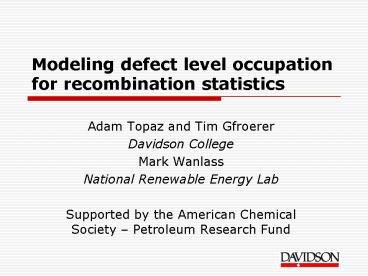Modeling defect level occupation for recombination statistics - PowerPoint PPT Presentation
1 / 39
Title:
Modeling defect level occupation for recombination statistics
Description:
Modeling defect level occupation for recombination statistics. Adam Topaz and Tim Gfroerer ... An occupation model that allows for thermal defect-to-band excitation. ... – PowerPoint PPT presentation
Number of Views:48
Avg rating:3.0/5.0
Title: Modeling defect level occupation for recombination statistics
1
Modeling defect level occupation for
recombination statistics
- Adam Topaz and Tim Gfroerer
- Davidson College
- Mark Wanlass
- National Renewable Energy Lab
- Supported by the American Chemical Society
Petroleum Research Fund
2
A semiconductor
Conduction Band
Defect States
Energy
Valence Band
3
Equilibrium Occupation in a Low Temperature
Semiconductor.
Holes
Electron Trap
Hole Trap
Electrons
4
Photoexcitation
Photon
5
Photoexcitation
Photon
6
Photoexcitation
7
Photoexcitation
8
Radiative Recombination.
9
Radiative Recombination.
10
Radiative Recombination.
11
Electron Trapping.
12
Electron Trapping.
13
Defect Related Recombination.
14
Defect Related Recombination.
15
Defect Related Recombination.
16
What do we measure?
- Recombination rate includes radiative and
defect-related recombination. - Measurements were taken of radiative efficiency
vs. recombination rate. - (radRate)/(radRatedefRate)
- vs. (radRate defRate)
- Objective Information about the defect-related
density of states.
17
The Defect-Related Density of States (DOS)
Function
Conduction Band
Defect States
Energy
Ev
Ec
Energy
Valence Band
18
Band Density Of States
Conduction Band
Valence Band
Energy
Energy
19
Looking at the Data
20
Calculate x-Axis Use Rate value for y-Axis
- dP hole concentration in valence band
- dN electron concentration in conduction band
21
The simple theory
- Assumptions
- dP dN n
- Defect states located near the middle of the gap
- No thermal excitation into bands.
- Fitting the simple theory
- radB is given.
- Find defA to minimize logarithmic error
- defA is the defect related recombination constant
- radB is the radiative recombination constant.
22
Simple Theory Fit
23
A Better Model
- Assumptions
- defA independent of temperature (and is related
to the carrier lifetime) - Calculations
- Calculate Ef for a given temperature, bandgap and
defect distribution - Calculate QEfp / QEfn for a given exN (the value
of exN is chosen to match experimental dPdN) - Calculate occupations (dP, dN, dDp, and dDn)
- dDp trapped hole concentration
- dDn trapped electron concentration
- Ef is the Fermi energy
- QEFp/n is the quasi-Fermi energy for holes and
electrons respectively - exN is the number of excited carriers
24
Calculating Ef
- The Fermi energy Ef is the energy where
- ( empty states below Ef) ( filled states
above Ef) - Red area Blue area
Ef
Valence Band
Conduction Band
Defect States
Energy
25
Calculating QEFp and QEFn
- Find QEFp and QEFn such that
- exN increased occupation (red area)
Increased hole occupation
Increased electron occupation
Ef
Ef
QEFn
QEFp
Filled Hole States
Filled Electron States
exN
exN
Energy
Energy
26
Calculating band occupations
- dP and dN depend on QEFp and QEFn, respectively.
QEFn
QEFp
Conduction Band
Valence Band
dN
dP
Energy
Energy
27
Calculating defect occupation
- dDp and dDn depend on Ef, and QEFs
Trapped hole occupation
Trapped electron occupation
QEFn
Ef
Ef
QEFp
Electron Traps
dDn
dDp
Hole Traps
Energy
Energy
Note graph represents an arbitrary midgap defect
distribution
28
Symmetric vs. Asymmetric defect distribution
- Symmetric Defect DOS
Ev
Ec
29
Symmetric Defect Fit
30
Asymmetric defect DOS
- Using 2 Gaussians(fit for 2 Gaussians)
Ev
Ec
31
2-Gaussian Asymmetric Fit
32
3-Gaussian Asymmetric Fit.
Ev
Ec
33
3-Gaussian Asymmetric Fit
34
Conclusion
- Simple Theory ? Defect slope is too steep and
theory does not allow for temperature dependence! - Temperature dependence and shallow defect slope
can be modeled using - An occupation model that allows for thermal
defect-to-band excitation. - An asymmetric defect level distribution
35
In-depth look at the model
- Calculating DOS(e)
- DOS(e) ValenceBand(e) ConductionBand(e)
defDos(e) - ValenceBand(e) 0 if e gt Ev, if e gt Ev
- ConductionBand(e) 0 if e lt Ec, if e lt Ec
- defDos(e) is an arbitrary function denoting the
defect density of states. defDos(e) 0 when e lt
Ev or e gt Ec
36
Fermi Function, and calculating Ef
- Fermi Function
- To calculate Ef, find Ef where
37
Calculating QEFp/n
- QEFp denotes the point where
- QEFn denotes the point where
38
Calculating Occupations
Note see slide 7 for rate value.
39
Numerical Infinite Integrals
- Need a bijection
- And
- Then
- Using ArcTan,































